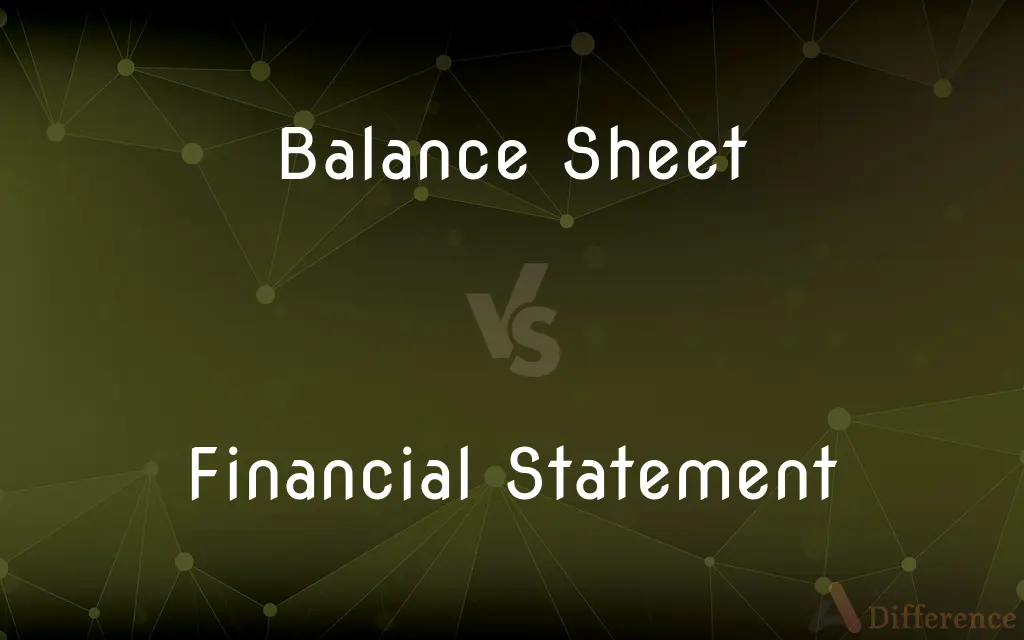Balance Sheet vs. Financial Statement — What's the Difference?
By Tayyaba Rehman — Published on October 5, 2023
A Balance Sheet is a financial snapshot showing a company's assets, liabilities, and equity at a specific point in time, while a Financial Statement is a formal record of a business's financial activities, including the income statement, balance sheet, an

Difference Between Balance Sheet and Financial Statement
Table of Contents
ADVERTISEMENT
Key Differences
A Balance Sheet is one component of the financial statements, representing the financial position of a company at a particular moment, detailing its assets, liabilities, and shareholders’ equity. Conversely, a Financial Statement is a comprehensive collection of a company’s financial information, including the balance sheet, income statement, and statement of cash flows, reflecting the financial performance and position of a company over a specified period.
The Balance Sheet provides invaluable insights into what a company owns (assets) and owes (liabilities), along with the amount invested by shareholders (equity). In contrast, the Financial Statement provides a broader view of a company’s financial health, giving stakeholders detailed information on the company's profitability, financial position, and cash flows, enabling them to make informed decisions.
While the Balance Sheet focuses solely on presenting a company’s financial position at a single point in time, the Financial Statement incorporates multiple reports, each offering different perspectives on the financial health of the business, including revenue generation, expense management, asset utilization, and cash movement.
The Balance Sheet’s snapshot nature allows stakeholders to assess the company’s financial stability, liquidity, and solvency. However, the Financial Statement goes beyond, allowing for a more holistic analysis by including additional reports like the income statement, which highlights profitability, and the cash flow statement, which tracks cash movements.
To sum up, while the Balance Sheet is crucial for understanding a company’s financial position at a specific time, a Financial Statement offers a more comprehensive overview of a company’s financial activities, allowing for an in-depth analysis of its performance, stability, and profitability.
ADVERTISEMENT
Comparison Chart
Definition
A snapshot of a company's assets, liabilities, and equity at a specific point in time.
A comprehensive record of a business's financial activities and performance.
Components
Assets, Liabilities, and Equity.
Includes the Balance Sheet, Income Statement, and Statement of Cash Flows.
Purpose
To depict a company's financial position at a particular moment.
To present a detailed overview of a company's financial health and performance.
Timeframe
Represents a single point in time.
Covers a specific period, typically a fiscal quarter or year.
Users
Used by stakeholders to assess financial stability, liquidity, and solvency.
Utilized by stakeholders to make informed decisions based on overall financial health.
Compare with Definitions
Balance Sheet
A Balance Sheet is a financial statement depicting a company's assets, liabilities, and shareholders' equity at a specific time.
The Balance Sheet revealed the company’s strong financial position with high asset values.
Financial Statement
A Financial Statement includes the balance sheet, income statement, and statement of cash flows.
A detailed review of the Financial Statement is crucial for assessing a company’s overall financial health.
Balance Sheet
A Balance Sheet provides a snapshot of a company’s financial condition at a single point in time.
The end-of-year Balance Sheet showed a significant increase in the company’s equity.
Financial Statement
Financial Statements are used by management, investors, and other stakeholders to make informed business and investment decisions.
Investors closely studied the Financial Statement to evaluate the company’s earning potential and risk.
Balance Sheet
A Balance Sheet is composed of two main sections: assets on one side and liabilities plus shareholders’ equity on the other.
The discrepancies in the Balance Sheet prompted a thorough review of assets and liabilities.
Financial Statement
Financial Statements provide a summary of a company’s revenue, expenses, assets, liabilities, and cash flows.
The Financial Statement was scrutinized to discern the company’s operational profitability and asset utilization efficiency.
Balance Sheet
A Balance Sheet allows stakeholders to evaluate a company’s financial stability, liquidity, and solvency.
Analysts referred to the Balance Sheet to assess the company's ability to meet its long-term obligations.
Financial Statement
A Financial Statement is a structured representation of the financial performance and position of a company.
The Financial Statement revealed the company’s robust profitability and positive cash flows.
Balance Sheet
A Balance Sheet is essential for internal and external stakeholders to understand the company's financial standing at a given moment.
The annual Balance Sheet was meticulously scrutinized by investors interested in the company’s financial health.
Financial Statement
A Financial Statement reflects the financial activities and conditions of a business over a specific period.
The annual Financial Statement provided comprehensive insights into the company’s operational efficiency and financial strategies.
Common Curiosities
Why is a Balance Sheet important?
A Balance Sheet is important as it provides a snapshot of a company’s financial condition, allowing stakeholders to assess its stability, liquidity, and solvency.
How do Financial Statements assist stakeholders?
Financial Statements assist stakeholders by providing comprehensive insights into a company's financial health, enabling informed business and investment decisions.
What does a Financial Statement include?
A Financial Statement includes the balance sheet, income statement, and statement of cash flows.
Can a Balance Sheet reveal a company’s financial health?
Yes, a Balance Sheet can reveal a company’s financial health by showcasing its assets, liabilities, and equity, reflecting its financial stability and solvency.
What purpose do Financial Statements serve for investors?
Financial Statements serve to inform investors about a company’s financial performance, profitability, and risk, aiding in investment decisions.
Is the Balance Sheet a component of the Financial Statement?
Yes, the Balance Sheet is a crucial component of the Financial Statement, depicting the company’s financial position at a specific time.
How does the Balance Sheet assist in assessing a company’s liquidity?
The Balance Sheet assists by listing current assets and liabilities, allowing for the assessment of a company's ability to meet short-term obligations.
What insights can stakeholders gain from Financial Statements?
Stakeholders can gain insights into a company’s profitability, asset utilization, cash flows, financial stability, and overall financial condition from Financial Statements.
What does a Balance Sheet represent?
A Balance Sheet represents a company's assets, liabilities, and equity at a specific point in time.
How often are Financial Statements usually prepared?
Financial Statements are usually prepared quarterly and annually, providing insights into a company's financial performance over a specified period.
Can the Balance Sheet provide insights into a company’s solvency?
Absolutely, the Balance Sheet provides insights into a company’s solvency by illustrating the relationship between its assets, liabilities, and equity.
Share Your Discovery

Previous Comparison
Pen Drive vs. USB Drive
Next Comparison
Smartphone vs. Feature PhoneAuthor Spotlight
Written by
Tayyaba RehmanTayyaba Rehman is a distinguished writer, currently serving as a primary contributor to askdifference.com. As a researcher in semantics and etymology, Tayyaba's passion for the complexity of languages and their distinctions has found a perfect home on the platform. Tayyaba delves into the intricacies of language, distinguishing between commonly confused words and phrases, thereby providing clarity for readers worldwide.











































